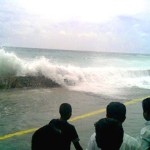
Digital News Report- It’s been four years since the Asian Tsunami claimed 283,100 lives (14,100 missing) and displaced 1,126,900 people, but the relief efforts are still ongoing. The tsunami occurred on December 26th, 2004 and was the result of a 9.2 earthquake that struck off the coast of Indonesia. It was the second largest earthquake ever recorded.
At least 82 of the dead, and as many as 108, were from the island nation of the Maldives where the American Red Cross is continuing the process of relocating the 3,600 people left homeless on Kandolhudhoo due to the disaster. The Maldives is a group of Atolls in the Indian Ocean known for its natural beauty and diving opportunities.
Instead of rebuilding infrastructure on the devastated island, the Maldives government determined that the nearby island of Dhuvaafaru would be a safer alternative for the population because it is more protected from future tsunamis. “Dhuvaafaru is one example of our long-term commitment to ensure communities rebuild in a sustainable way and are prepared for future disasters,” says Gerald Anderson, Senior Director of the American Red Cross Tsunami Recovery Program.

Construction teams have built 600 houses, a preschool, a primary and secondary school, an auditorium, an administration building, roads, an electrical grid, a sewer and waste system and a rainwater collection system. Parts of the island were also raised to provide safe areas for families during future disasters. A housing lottery was held and the residents of Kandolhudhoo are set to relocate later this month.
Over 2/3 of the capital city of Male was flooded during the tsunami. Maldives has the record of have the lowest high point of any country on earth. Many of it’s outlying atolls were severely damaged during the tsunami, including Kandolhudhoo.
